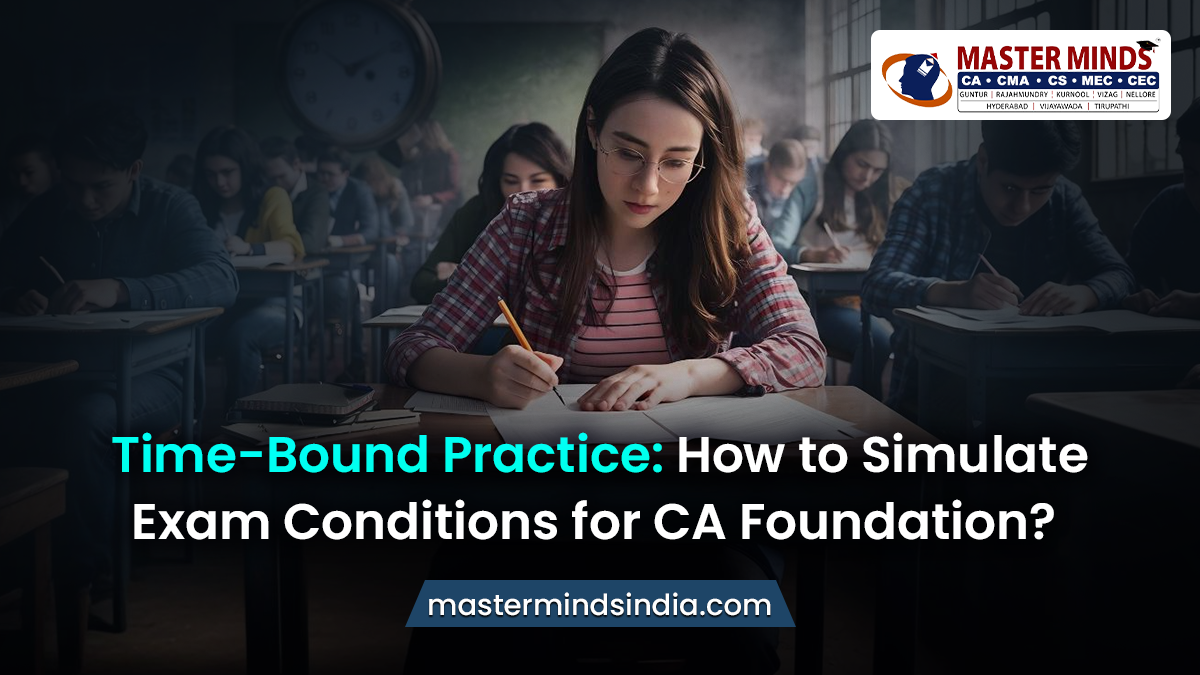Time-Bound Practice: How to Simulate Exam Conditions for CA Foundation?

Welcome to Mastermindsindia.com. In the rigorous journey toward CA Foundation success, mastering the art of time management under exam conditions can make or break your performance. Imagine yourself stepping into the examination hall, facing the clock ticking down and the pressure building—how prepared will you be? To ensure you’re not just ready but primed for excellence, it’s crucial to practice under authentic conditions that mirror the exam day experience.
This guide unveils the secrets of time-bound practice, offering a comprehensive strategy to simulate real exam scenarios. Prepare to transform your study routine into a high-stakes rehearsal that will elevate your performance and propel you toward your CA Foundation goals.
Understanding the Exam Format
Objective: Grasp the structure and timing of CA Foundation exams
- Action: Begin by thoroughly reviewing the CA Foundation exam format. Understand the distribution of questions, the types of questions (multiple-choice, descriptive), and the overall timing constraints.
- Activity: Create a mock exam paper that mirrors the actual exam structure. This should include a variety of question types and adhere to the same time limits as the real exam.
Key Focus: Familiarize yourself with the exam’s layout and timing to ensure your practice sessions accurately reflect the actual test conditions.
Creating Your Time-Bound Practice Sessions
Objective: Design effective practice sessions that replicate exam conditions.
- Week 1: Structured Timed Tests
- Action: Start with timed practice tests that reflect the actual duration of the CA Foundation exams. Aim to complete these tests within the set time limits, simulating exam pressure.
- Activity: Use a stopwatch or timer to enforce strict adherence to the allotted time. After completing each test, review your performance to identify areas for improvement.
- Week 2: Full-Length Mock Exams
- Action: Gradually increase the length and complexity of your practice sessions to match the full CA Foundation exam. Include breaks to mimic the real exam schedule.
- Activity: Set up a quiet, distraction-free environment similar to the exam hall. Take the mock exam under realistic conditions, including timing, breaks, and exam materials.
Key Focus: Build endurance and adaptability by practicing full-length exams and managing time effectively under simulated exam conditions.
Developing Speed and Accuracy
Objective: Enhance your speed and accuracy through focused practice.
- Week 3: Speed Drills and Accuracy Checks
- Action: Incorporate speed drills into your practice routine. Focus on answering questions quickly while maintaining accuracy.
- Activity: Set time limits for answering individual questions or sections. Track your progress and adjust your strategies to improve both speed and accuracy.
- Week 4: Error Analysis and Strategy Refinement
- Action: After each timed practice session, conduct a thorough analysis of mistakes. Identify patterns in errors and refine your strategies to address them.
- Activity: Maintain a journal of common mistakes and develop targeted practice exercises to overcome them.
Key Focus: Enhance your ability to quickly and accurately answer questions, turning mistakes into learning opportunities and refining your exam strategies.
You Can Also Read:
- CA Intermediate New Study Material
- CA Course Duration After 10th, 12th & Graduation
- Tips to Crack CA in First Attempt
- Time-Saving Calculator Tricks for CA Foundation Students
- How to become a CA?
- CA Foundation New Syllabus
- CA Inter New Syllabus
- ICAI CA New Scheme
Implementing Effective Time Management Strategies
Objective: Apply time management techniques to improve exam performance.
- Week 5: Time Management Techniques
- Action: Experiment with various time management techniques such as the Pomodoro Technique or the 80/20 Rule during practice sessions. Find what works best for you.
- Activity: Apply these techniques to your timed practice tests to see how they affect your performance. Adjust your approach based on what improves your efficiency.
- Week 6: Prioritization and Strategic Pacing
- Action: Develop strategies for prioritizing questions and sections based on their difficulty and point value. Practice pacing yourself to ensure you complete the exam within the allotted time.
- Activity: Use practice tests to implement these strategies, adjusting your pacing and prioritization based on your performance.
Key Focus: Master time management techniques and strategies to effectively navigate the exam, ensuring you maximize your performance.
Maintaining Focus and Reducing Stress
Objective: Cultivate focus and manage stress during timed practice.
- Week 7: Focus Training and Stress Management
- Action: Incorporate focus training exercises into your routine to improve concentration during practice sessions. Use techniques such as mindfulness or relaxation exercises to manage stress.
- Activity: Practice meditation or deep-breathing exercises before and during timed practice sessions. Develop a pre-exam routine to maintain calm and focus.
- Week 8: Final Practice and Exam Simulation
- Action: Conduct a final comprehensive mock exam under conditions that closely resemble the actual exam. Use this opportunity to test your time management, focus, and stress management strategies.
- Activity: Analyze your performance in the final simulation, identifying any last-minute adjustments needed to optimize your exam readiness.
Key Focus: Develop mental resilience and effective focus strategies to handle the pressure of the real exam with confidence.
CA & CMA Online Classes:

